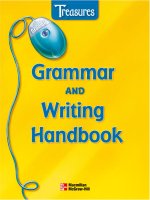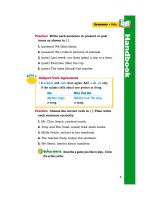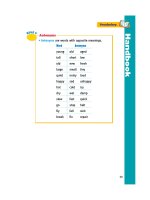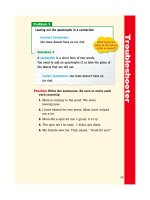grammar and writing handbook grade 3
Bạn đang xem bản rút gọn của tài liệu. Xem và tải ngay bản đầy đủ của tài liệu tại đây (8.22 MB, 256 trang )
Grade 3
Grammar
AND
Writing
Handbook
Published by Macmillan/McGraw-Hill, of McGraw-Hill Education, a division of The McGraw-Hill Companies, Inc.,
Two Penn Plaza, New York, New York 10121.
Copyright © by Macmillan/McGraw-Hill. All rights reserved. No part of this publication may be reproduced
or distributed in any form or by any means, or stored in a database or retrieval system, without the prior written
consent of The McGraw-Hill Companies, Inc., including, but not limited to, network storage or transmission, or
broadcast for distance learning.
Printed in the United States of America
1 2 3 4 5 6 7 8 9 079 11 10 09 08 07
A
Contents
Writing
7 Personal Narrative
8 Literature Models
10 Features of Personal Narrative
12 Writing Process
12 Prewrite
14 Research and Inquiry
16 Draft
18 Revise
22 Proofread/Edit
24 Publish
26 Writing Rubric
27 Persuasive Writing
28 Literature Models
30 Features of Persuasive Writing
32 Writing Process
32 Prewrite
34 Research and Inquiry
36 Draft
38 Revise
42 Proofread/Edit
44 Publish
46 Writing Rubric
47 Fictional Narrative: A Story
48 Literature Models
50 Features of a Story
52 Writing Process
52 Prewrite
54 Research and Inquiry
56 Draft
58 Revise
62 Proofread/Edit
64 Publish
66 Writing Rubric
3
Contents
Writing
67 Expository Writing: A How-To
68 Literature Models
70 Features of How-to Writing
72 Writing Process
72 Prewrite
74 Research and Inquiry
76 Draft
78 Revise
82 Proofread/Edit
84 Publish
86 Writing Rubric
87 Expository Writing: Writing That Compares
88 Literature Models
90 Features of Writing That Compares
92 Writing Process
92 Prewrite
94 Research and Inquiry
96 Draft
98 Revise
102 Proofread/Edit
104 Publish
106 Writing Rubric
107 Expository Writing: Research Report
108 Literature Models
110 Features of Expository Writing:
Research Report
112 Writing Process
112 Prewrite
114 Research and Inquiry
116 Draft
118 Revise
122 Proofread/Edit
124 Publish
126 Writing Rubric
4
Contents
Writing
128 Composition
128 Main Idea and Supporting Details
129 Organization
130 Leads and Endings
131 Writing Descriptions
132 Outlining
133 Beginning, Middle, End
134 Writing Forms
134 Poem
135 Business Letter
136 Play
137 Editorial
Grammar
138 Grammar and Usage
138 Sentences
141 Nouns
144 Verbs
151 Pronouns
154 Adjectives
156 Adverbs
158 Mechanics
158 Abbreviations
160 Capitalization
163 Punctuation
166 Extra Practice
5
Contents
Build Skills
222 Study Skills
222 Dictionary
223 Card Catalog
224 Parts of a Book
225 Note-taking and Summarizing
226 Library Catalog Menu
227 Periodicals
228 Graphs
229 Internet: Online Search
230 Encyclopedia
231 Telephone Directory
232 Thesaurus
233 Map/Atlas
234 Vocabulary
240 Spelling
Troubleshooter
244 Troubleshooter
244 Correcting Sentence Fragments
246 Correcting Run-on Sentences
248 Confusing Plurals and Possessives
250 Lack of Subject-Verb Agreement
252 Incorrect Verb Forms
254 Incorrect Use of Pronouns
256 Incorrect Use of Adjectives
6
1
UnitUnit
Personal Narrative
7
Literature Models
AND
WRITE
TH NK
Purpose
Why do you think
people write personal
narratives? Explain
what you think in
your journal. Also tell
why people like to
read them.
Personal Narrative
A personal narrative is a true story that you tell
about yourself. When you write a personal narrative,
you tell about something that happened to you and
how you felt about it.
Learning from Writers
Read the following examples of personal narrative.
What stories do the writers tell? Why do you think
they wanted to share their experiences? As you read,
notice how each author tells about feelings.
The last time I saw him, my grandfather said that he
longed to see California one more time. He never did.
And when I was nearly grown, I left home and went
to see California for myself.
After a time, I came to love the land my
grandfather had loved, and I stayed on and on until I
had a daughter of my own.
But I also miss the mountains and rivers of my
childhood. I miss my old friends. So I return now and
then, when I can not still the longing in my heart.
The funny thing is, the moment I am in one
country, I am homesick for the other.
— Allen Say, from Grandfather's Journey
8
The Canoe Trip That Never Happened
Last summer, my mom and my
aunt suggested we go canoeing on
the Green River. I was excited!
Before we left, we bought a new
tent and life jackets. We studied
maps and planned where we should
camp each night.
Early one morning, we packed up
the car and drove to the Green River.
Surprise! The river was brown and full
of trash. There had been so much rain,
it was flooding. Our careful plans
were ruined.
We stayed in motels and visited
museums. It was okay, but not as much
fun as canoeing. I hope we can try again
next year.
— Maryann Kopek
Literature Models
PRACTICE AND APPLY
Thinking Like a Reader
1. Name three events in Allen
Say’s narrative in the order
they happened.
2. How did Maryann Kopek
feel before and after the
canoe trip?
Thinking Like a Writer
3. How did the author let you
know the order of events in
“A Man of Two Countries”?
4. What words did Maryann
Kopek use to show how
she felt?
5. Reading Across Texts Compare the beginning paragraphs
of the two personal narratives. Write about how they are alike
and different.
9
Literature Models
▶
A Personal Experience
Reread “A Man of Two Countries” on page 8.
Who is the story about?
So I return now and then, when I can not still the
longing in my heart.
The words I and my let you know that the author
is telling about an experience in his own life.
▶
The Writer’s Feelings
What words does the author use to tell you about
his feelings?
But I also miss the mountains and rivers of my
childhood. I miss my old friends.
When the author says, “I miss my old friends,”
you can tell he is feeling sad.
A personal narrative is writing that tells a true story
about your own life. A good personal narrative:
▶
Tells a story from the writer’s personal
experience using words like I, my, and me.
▶
Expresses the writer’s feelings.
▶
Has an interesting beginning, middle,
and ending.
▶
Uses time-order words to share events in the
order they happened.
Features of
Personal Narrative
DEFINITIONS AND FEATURES
10
Literature Models
PRACTICE AND APPLY
Create a Features Chart
1. List the features of a good personal narrative.
2. Reread “The Canoe Trip That Never
Happened” by Maryann Kopek on page 9.
3. Write one example of each feature in
Maryann’s writing.
4. Write what you liked about Maryann’s
personal narrative.
▶
An Interesting Beginning, Middle,
and Ending
How does Allen Say catch your attention with
this beginning?
The last time I saw him, my grandfather said that
he longed to see California one more time.
This beginning may make you wonder why his
grandfather’s wish was important to the author.
Why is the following sentence a good ending?
The funny thing is, the moment I am in one country,
I am homesick for the other.
▶
Time-Order Words
To help your reader clearly understand what
happened, use time-order words and phrases
such as at first, then, last week, and finally.
After a time, I came to love the land my grandfather had
loved . . .
What time-order phrase did the author use?
?^Zmnk^l
>qZfie^l
11
PROCESSPROCESS
Personal Narrative
Prewrite
A personal narrative is a true story about
yourself. Writing a personal narrative gives you a
chance to tell about your own life.
Purpose and Audience
The purpose for writing a personal narrative is to
share how you feel about an experience in your life.
It is also to entertain your readers, or audience.
Before you begin to write, think about your
audience. Who will be reading your story? How can
you help your readers get to know you?
Choose a Topic
Begin by brainstorming a list of people who are
special to you. Choose one person to write about.
Then explore ideas by listing what you remember
about being with this person.
AND
WRITE
TH NK
Audience
How will you help
your readers know
how you feel about
a special person?
Write your answer.
I explored
my ideas by
making a list.
Aunt Jane
Aunt Jane is fun
Lets me try new things
Taught me how to swim
Let me feed baby Alex
Alex spit out the food
12
DRAFT
REVISE
PROOFREAD
PUBLISH
PREWRITE
Aunt Jane
fun
let me feed Baby Alex
Alex spit out the food
We laughed
doesn't mind mistakes
lets me try new things
taught me how to swim
CLUSTER MAP
Organize • Clustering
Your narrative will have two main parts. First,
you will tell about a special person. Then you will
tell about something that happened when you were
with that person. To plan your narrative, you can
use a cluster map. How did this writer organize the
ideas from his list?
EgZlg^i^c\
■
Have you thought
about your purpose
and audience?
■
Have you chosen
one person and
event to tell about?
■
Have you made a
list of ideas about
the person and the
experience?
■
Are your ideas
organized in a
cluster map?
■
Do you need to do
any research?
PRACTICE AND APPLY
Plan Your Own Personal Narrative
1. Think about your purpose and audience.
2. Choose a topic.
3. Brainstorm ideas about your topic.
4. Organize your ideas.
13
PROCESS
Personal Narrative
What Else Do I Need
to Know?
What was Alex eating?
Are there better words to
describe what happened?
Where Can I Find the
Information?
E-mail Aunt Jane to find out.
Look in the dictionary.
▶
Conduct an Interview
An interview is a conversation. One person
asks questions and the other person answers. An
interview can take place in person, in writing, on
the telephone, or by e-mail.
Prewrite
•
Research and Inquiry
▶
Writer’s Resources
You may need to get more information for your
personal narrative. Make a list of questions. Then
decide where you can find the answers.
EFMFUFTBWFQSJOUGJMFSFBEOFX
."* "9
Aunt Jane, do you remember
the first time I tried to feed Alex?
What was that orange food in
the jar?
Timmy, it was strained squash.
STRATEGIES FOR INTERVIEWING
• Know what you want to ask. Write down your
questions.
• Take notes so you can remember the answers.
• Be polite and friendly. Always thank the person
at the end of an interview.
14
DRAFT
REVISE
PROOFREAD
PUBLISH
PREWRITE
let me feed Baby Alex
Alex spit out the food
doesn't mind mistakes
strained squash
The squash came
shooting out.
lets me try new things
▶
Use a Dictionary
You can find the spelling and meanings of words
in a dictionary. Use alphabetical order to find words.
Sometimes the dictionary meaning of a word can tell
you other ways to say the same thing.
▶
Use Your Research
New information gathered from your research
can go into your cluster map. This writer learned
two things from his research. How did he change
his map?
PRACTICE AND APPLY
Review Your Plan
1. Look at your cluster map.
2. List questions you have about your topic.
3. Identify the resources you will need
to find answers.
4. Add new information you gather to
your map.
GZhZVgX]
VcY>cfj^gn
■
Did you list your
questions?
■
Did you identify
possible resources?
■
Did you take notes?
15
PROCESS
Personal Narrative
Drafting
■
Does your narrative
fit your purpose
and audience?
■
Have you included
your thoughts and
feelings?
■
Have you written a
good beginning?
■
Have you included
details that will
help readers feel as
though they were
there?
■
Does your narrative
have an interesting
ending?
Draft
Before you begin writing your personal narrative,
review the cluster map you made. Think about
making a paragraph for each main idea. Include
details that support each main idea.
Aunt Jane
fun
let me feed Baby Alex
Alex spit out the food
We laughed
doesn't mind mistakes
lets me try new things
taught me how to swim
CLUSTER MAP
strained squash
The squash came
shooting out.
This idea can be
a good ending.
Main idea for first
paragraph: Why I like
visiting Aunt Jane.
Main idea for second
paragraph: What
happened at
my aunt’s.
16
PREWRITE
REVISE
PROOFREAD
PUBLISH
DRAFT
This is about my Aunt Jane. Keeps me busy all
the time. We have a lot of fun together, even when
I make mistakes. She lets me try new things. She
even taught me how to swim.
One time a very funny thing happened. Baby
Alex was hungry. Aunt Jane asked, "Do you want
to try feeding him." So we put Alex into his high
chair. We got out a jar of strained squash.
I spooned some into Alex's mouth. It came shooting
right back out! It got all over me. Alex made a funny
face Aunt Jane and I just laughed and laughed.
Look at how this writer used the ideas in his
cluster map to write a first draft. He added details
about Aunt Jane in the first paragraph. Then he
told about something that happened when he was
with her.
PRACTICE AND APPLY
Draft Your Own Personal Narrative
1. Review your prewriting cluster map.
2. Write about how you felt.
3. Tell about things in the order they happened.
Supporting
details tell what
happened.
Supporting
details tell about
the writer's aunt.
Main idea
of first
paragraph
Main idea of
second paragraph
DRAFT
TECHNOLOGY
Find out how to
change line spacing
on your computer.
It’s a good idea to
double space your
draft so that you
have room to write
in changes after
you print it out.
17
PROCESS
Personal Narrative
Elaborate
One way to improve your writing is to elaborate.
When you elaborate, you add important ideas and
details that create a clear picture for the reader.
When you revise your personal narrative, you may
need to tell more about your feelings.
The writer added a detail that helps the reader
know how he feels.
Revise
TIME-ORDER
WORDS
first
next
then
later
after
last
before
as soon as
finally
this morning
yesterday
last summer
tomorrow
a long time ago
Word Choice
When you write, it is important to choose just the
right words for your topic and audience.
In a personal narrative, you need to find words
that will help you tell the events in the order they
happened.
The writer added a description of where the food
went to help the reader picture what happened.
This is about my Aunt Jane.
I love to visit
So we put Alex into his high chair. We got out
a jar of strained squash.
ThenFirst,
It got all over me.
my clothes. It was even in my hair.
18
PREWRITE
DRAFT
PROOFREAD
PUBLISH
REVISE
Better Sentences
As you are revising your draft, read your
sentences aloud. How do they sound? Have you
used different kinds of sentences? You can change
the rhythm of your writing by combining two
sentences.
Use and to connect two related sentences.
PRACTICE AND APPLY
Revise Your Own Personal Narrative
1. Add details that will make your writing clearer
and more interesting.
2. Use words that help the reader know exactly how
you felt.
3. Take out information that isn't necessary.
4. Grammar Should you combine any sentences?
TECHNOLOGY
Learn how to cut
and paste on the
computer so that
you can easily move
sentences and parts
of sentences when
you revise.
We got out a jar of strained squash. I spooned
some into Alex's mouth.
, and
19
PROCESS
Personal Narrative
Conferencing for the Reader
■
Did your partner include features of a
personal narrative?
• personal experience and feelings
• interesting beginning, middle, and ending
• time-order words
■
Tell your partner what is good about the
piece, as well as what could be better.
Revise
•
Peer Conferencing
Read the first draft of your personal narrative
aloud to your partner. Your partner may give you
some new ideas and suggestions.
This is about my Aunt Jane. Keeps me busy all
the time. We have a lot of fun together, even when
I make mistakes. She lets me try new things. She
even taught me how to swim.
One time a very funny thing happened. Baby
Alex was hungry. Aunt Jane asked, "Do you want to
try feeding him." So we put Alex into his high chair.
We got out a jar of strained squash. I spooned some
into Alex's mouth. It came shooting right back out!
It got all over me. Alex made a funny face Aunt
Jane and I just laughed and laughed.
How do you
feel about Aunt
Jane?
This detail
belongs in
another story.
This ending
makes me smile.
When did
this happen?
20
PREWRITE
DRAFT
PROOFREAD
PUBLISH
REVISE
Think about the comments and suggestions
of your partner when you revise your personal
narrative. This writer made some changes based on
his partner's ideas.
This is about my Aunt Jane. Keeps me busy all
the time. We have a lot of fun together, even when
I make mistakes. She lets me try new things. She
even taught me how to swim.
One time a very funny thing happened. Baby
Alex was hungry. Aunt Jane asked, "Do you want to
try feeding him." So we put Alex into his high chair.
We got out a jar of strained squash. I spooned some
into Alex's mouth. It came shooting right back out! It
got all over me. Alex made a funny face Aunt Jane
and I just laughed and laughed.
REVISE
My Aunt Jane
I love to visit
When I visited Aunt Jane last summer,
Best of all ,
Then
First,
, and
PRACTICE AND APPLY
Revise Your Own Personal Narrative
1. Read your draft aloud to your partner. Listen to
how it sounds.
2. Take notes on your partner's comments.
3. Use the notes from your peer conference to make
your draft better.
4. Add a title.
my clothes. It was even in my hair.
Revising
■
Does your story
suit your purpose
and audience?
■
Have you described
your feelings
clearly?
■
Did you include
enough details?
Did you choose
words carefully?
■
Are the events in
time order?
■
Do the sentences
flow easily when
read aloud?
■
Did you add a title?
21
PROCESS
Personal Narrative
Proofread/Edit
After you have revised your narrative, proofread
it to find and correct any mistakes in mechanics,
grammar and usage, and spelling.
GRAMMAR
• A sentence fragment is a group of words that
does not express a complete thought. You can
correct a sentence fragment by adding a subject
or a predicate.
MECHANICS
• Every sentence begins with a capital letter.
• A statement ends with a period.
• A question ends with a question mark.
• A command ends with a period.
• An exclamation ends with an exclamation mark.
REVIEW THE RULES
TECHNOLOGY
Use the spell
checker, but do not
expect it to find
every error. Read
your draft carefully.
Make sure that
each word is the
right word. For
example, you may
have typed “no” for
“on” by mistake.
STRATEGIES FOR PROOFREADING
• Reread your revised narrative, each time looking
for a different type of mistake. That way you will
have a better chance of catching all mistakes.
• Read for correct capitalization.
• Read for correct punctuation.
• Read aloud to check for sentence fragments.
• Check each word carefully to spot spelling
mistakes.
Go to pages 138–165 to review other rules.
22
DRAFT
REVISE
PROOFREAD
PUBLISH
PREWRITE
Look at the proofreading corrections made on
the draft below. What does the proofreading mark
mean? Why does the writer use that mark?
This is about my Aunt Jane. Keeps me busy all
the time. We have a lot of fun together, even when
I make mistakes. She lets me try new things. She
even taught me how to swim.
One time a very funny thing happened. Baby
Alex was hungry. Aunt Jane asked, "Do you want to
try feeding him." So we put Alex into his high chair.
We got out a jar of strained squash. I spooned some
into Alex's mouth. It came shooting right back out! It
got all over me. Alex made a funny face Aunt Jane
and I just laughed and laughed.
PROOFREAD
My Aunt Jane
I love to visit
Best of all ,
When I visited Aunt Jane last summer,
Then
She
First,
, and
PRACTICE AND APPLY
Proofread Your Own Personal Narrative
1. Correct spelling mistakes.
2. Include end punctuation for each sentence.
3. Correct sentence fragments.
4. Indent paragraphs.
?
my clothes. It was even in my hair.
Proofreading
■
Did you spell all
words correctly?
■
Did you begin and
end every sentence
correctly?
■
Is every sentence a
complete thought?
■
Did you indent the
paragraphs?
PROOFREADING
MARKS
new paragraph
add
take out
Make a capital
letter.
Make a small
letter.
Check the
spelling.
Add a period.
23
PROCESS
Personal Narrative
Publish
Review your personal narrative one more time
before you publish. Use this checklist.
The writer used the checklist to review his
narrative. Read “My Aunt Jane” and discuss it with
your classmates. Was the piece ready to publish?
Why or why not?
Personal Narrative
❑ Who was my audience? Did I write in a way that will
interest and entertain them?
❑ What was my purpose? Did I share how I felt about
my experience?
❑ Did I begin and end my story in an interesting way?
❑ Did I use time-order words to tell the order in which
things happened?
❑ Did I write complete sentences? Do they fit together
well?
❑ Did I proofread carefully and correct all mistakes?
24
by Timmy Chen
I love to visit my Aunt Jane. She keeps
me busy all the time. We have a lot of fun
together, even when I make mistakes. Best
of all, she lets me try new things.
When I visited Aunt Jane last summer, a
very funny thing happened. Baby Alex was
hungry. Aunt Jane asked, “Do you want to
try feeding him?”
First, we put Alex into his high chair.
Then we got out a jar of strained squash,
and I spooned some into Alex's mouth. It
came shooting right back out! It got all
over my clothes. It was even in my hair.
Alex made a funny face. Aunt Jane and I
just laughed and laughed.
PREWRITE
DRAFT
REVISE
PROOFREAD
PUBLISH
PRACTICE AND APPLY
Publish Your Own Personal Narrative
1. Check your revised draft one more time.
2. Make a neat final copy.
3. Add a cover and some drawings or photos.
TECHNOLOGY
Learn how to change
the font in your word
processing program.
For your final copy,
choose a font that is
easy to read.
25









